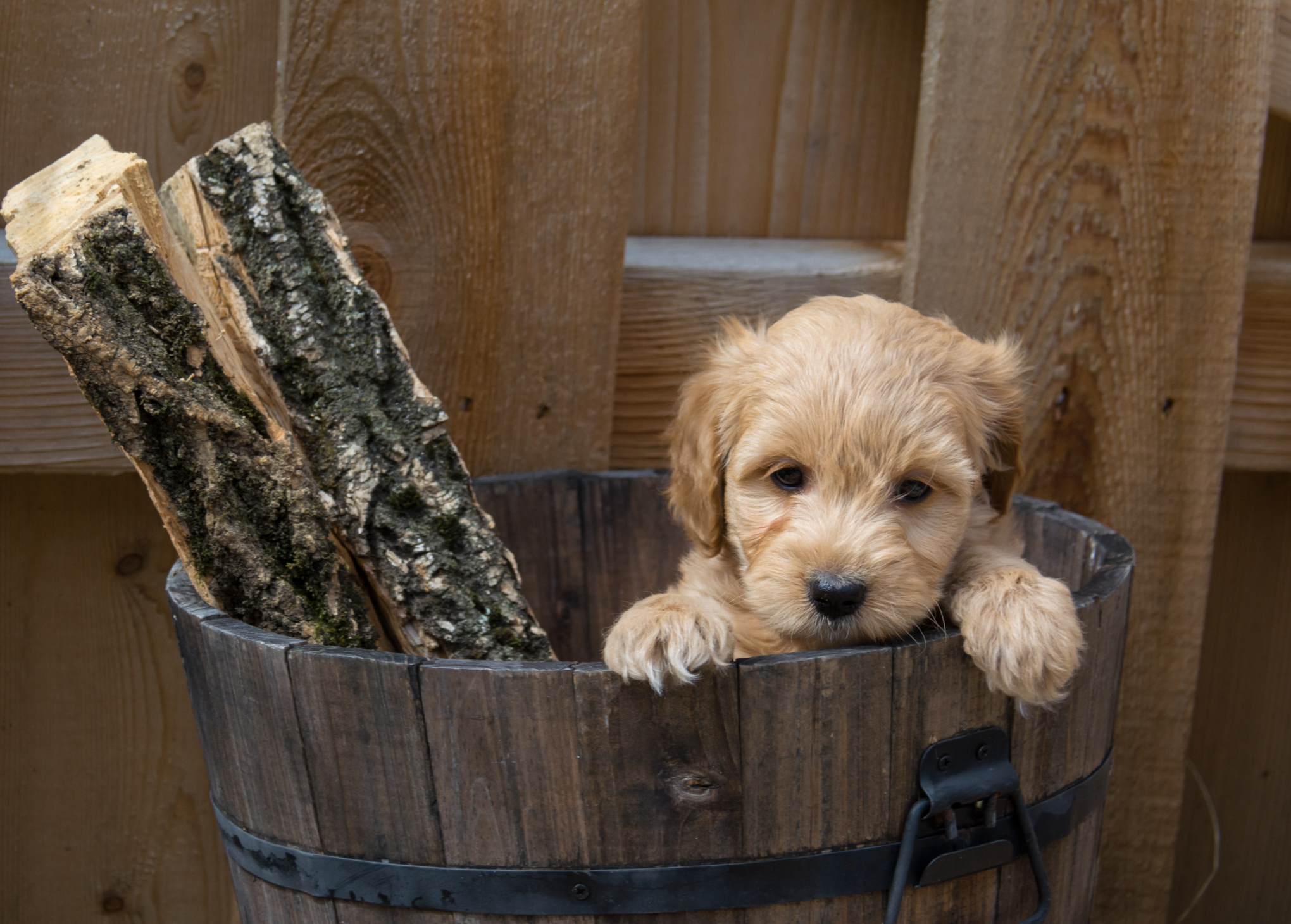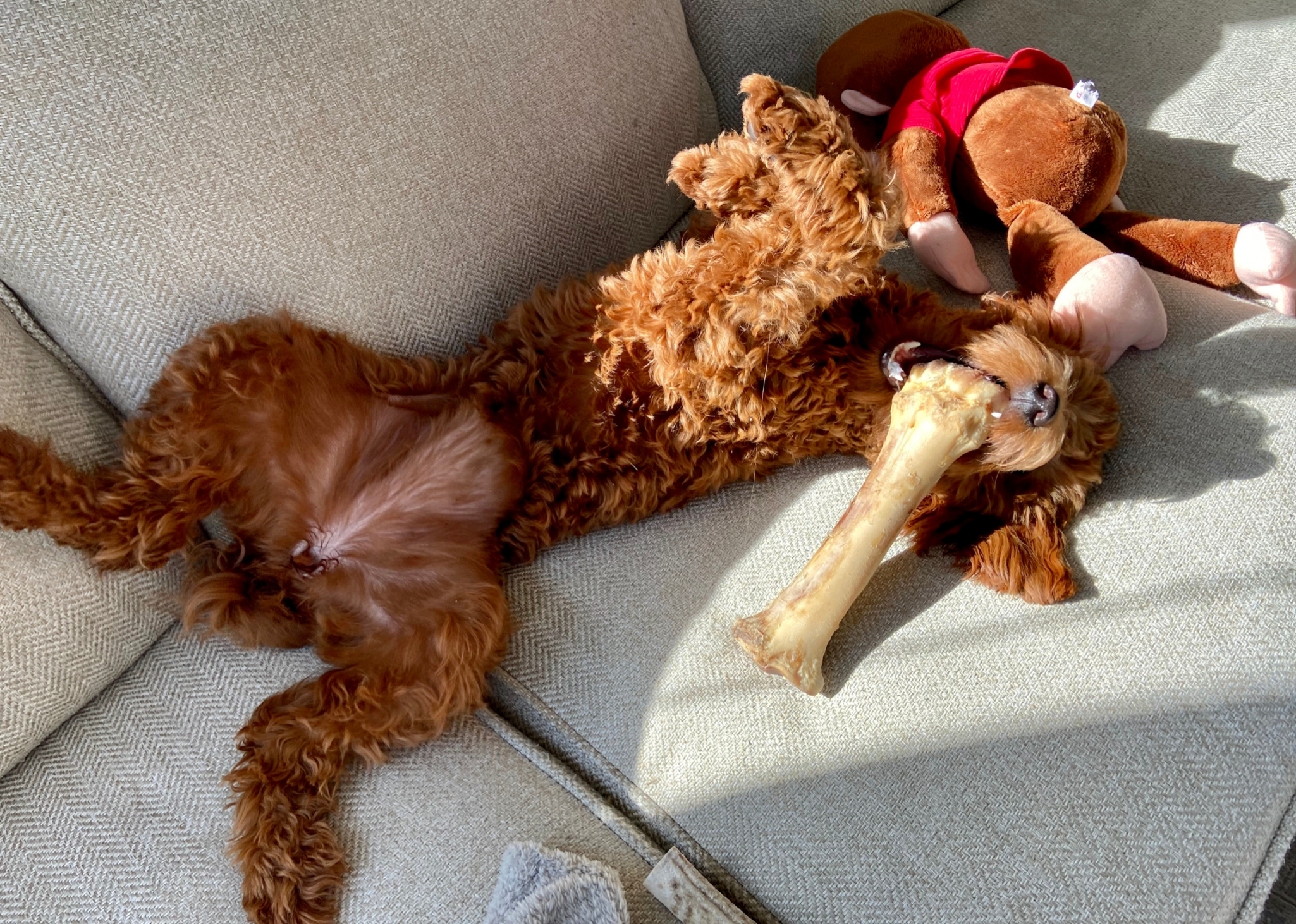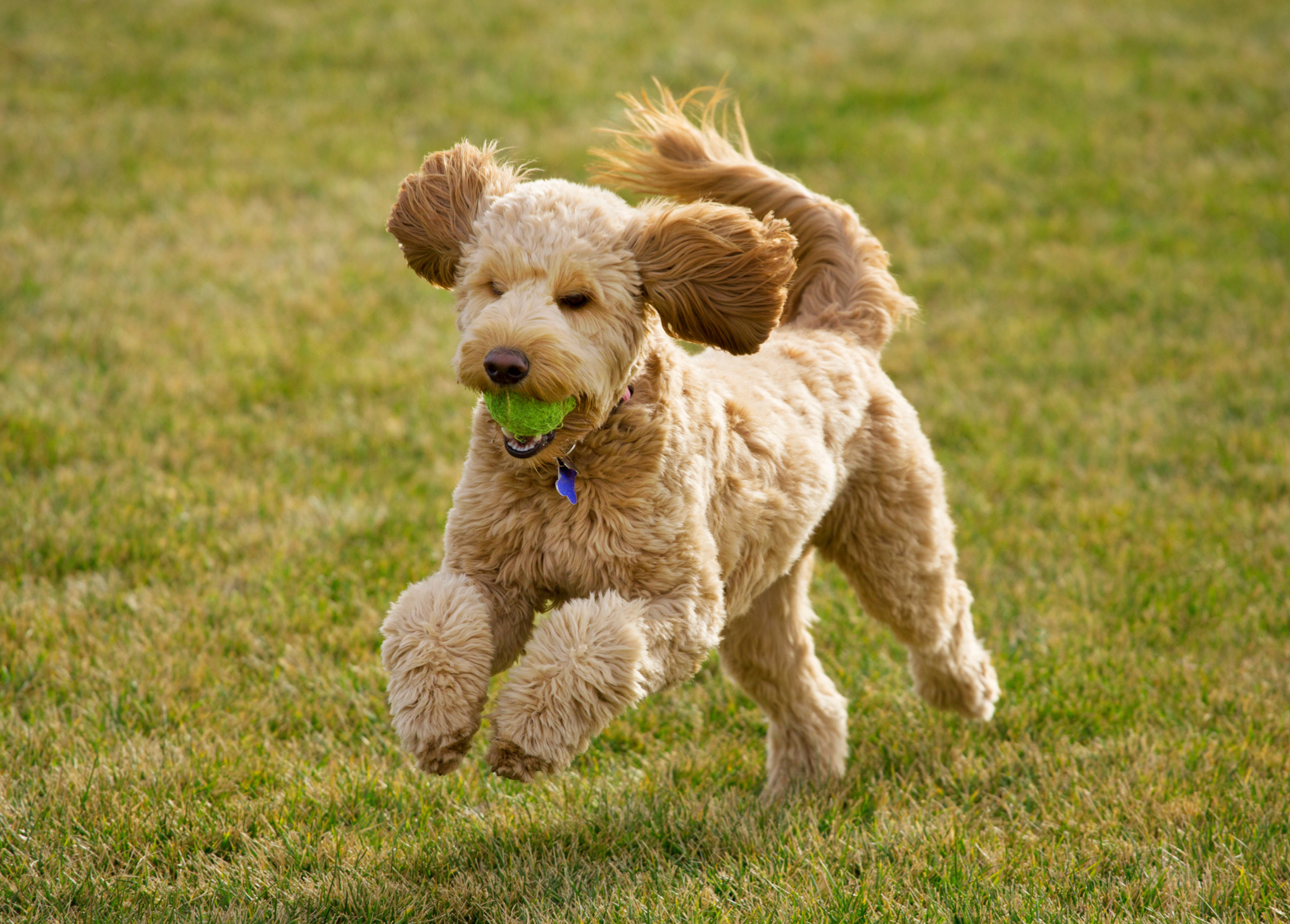If you recently brought home a new puppy or are in the midst of preparing, one of the first priorities for puppy parenthood is potty training! So how does a crate come into play when housebreaking, and what are other advantages to introducing a crate into your puppy’s training and life? Let’s dive in!
So what exactly is crate training and how will it help your puppy? Simply put, crate training is the process of acclimating your puppy to a designated space, or in this case a crate within your home. Crates tap into a puppy’s natural den animal instinct to keep their sleeping and hang-out area clean. Because of this pre-conditioned behavior, introducing a crate early on to your puppy will greatly help speed up the potty training process.
At The Puppy Academy, we recommend crate training because of all the benefits that come along with it for both the puppies and their owners. Aside from helping with potty training your puppy, a crate can prevent overstimulation, help your puppy with impulse control, learn to be left alone, build confidence and prevent separation anxiety, plus acts as their personal bedroom, giving them a place to relax, eat, and play in, all while providing structure and safety.
Now, introducing a crate to your puppy is more than just buying one and putting your puppy inside. We’ll walk you step-by-step to make the introduction so your puppy learns to feel comfortable and even love their crate, without risking creating a negative association, stress, or anxiety.
Key Benefits of Crate Training Your Puppy
While you may still be considering if you really need to incorporate a crate into your puppy’s daily life when used properly it becomes an indispensable tool for both you and your puppy! So, what are the key benefits of a crate?
A Safe Space of Their Own
Although the idea of letting your puppy free roam is tempting (it is their new home after all) young puppies are still learning the lay of the land and far too curious. A wide-open space invites the chance of your puppy getting into something they shouldn’t and, of course, surprise accidents all around the house.
Speeds Up Potty Training
As we briefly mentioned in the earlier section, puppies are den-animals. In the wild, wolves do not soil where they sleep and hang out. This same hangover instinct applies to dogs and puppies. Crating your puppy throughout the day and at night reduces the number of surprise accidents, and allows you to start getting your puppy on a consistent potty schedule.
Gets Them Used to Real-Life Situations
Throughout your puppy’s life, they will encounter situations where crating is inevitable. Overnights at the vet’s office, traveling by car or air, when people are over, or when you simply can’t supervise your puppy. Getting them comfortable with being inside a crate for periods of time alone will greatly help them adjust to those situations without stress and anxiety.
Builds Confidence and Resilience
Lastly, puppies that learn to be comfortable on their own in a crate, are far less likely to develop separation anxiety as young adults. Teaching your puppy how to be alone by utilizing their crate in another room of the house while you are home, or having them in there when you are away for short periods of time, will help transition your puppy to freely stay home alone when they are adults. This process will later provide you the peace of mind that they won’t be destructive and can be relaxed while being by themselves.
Picking the Right Crate
First thing’s first, you want to ensure that you are picking the right crate type and size for your puppy. A good rule of thumb is that it needs to be big enough for them to stand, turn, sit and lay down comfortably. And even though this may seem counter-intuitive, puppies feel more at ease in cozy and snug crates - think of dens in the wild that are small underground shelters - because it creates a sense of security. So, if your puppy is going to the bathroom on one side of the crate, and hanging out on the other side, it’s too big for them.
The pet supply market is saturated with different brands and varieties of crate types for puppies. We narrowed it down to tried and true crates, plus included a few tidbits to keep in mind about each crate option.
1. Plastic - We recommend and use plastic crates as much as possible at The Puppy Academy! Since these crates have sturdy plastic plus more coverage on the sides, puppies can’t see out as much which in turn helps to calm and settle them by blocking out unnecessary stimuli.
2. Metal Wire - An all-metal wire crate is also a great option for your puppy! Many of these crates come with dividers that you can use to adjust the size so your puppy can gradually grow into it and to avoid accidents inside the crate. These are a great option for large breed pups! If you are utilizing the divider, filling in the empty space with something solid can help your puppy settle down, by eliminating the open space they can see and want to get to.
3. Fabric - Although these collapsible crates are good for secondary shelter and convenient to take with you on short weekend trips, we don’t usually recommend these for young puppies! A soft fabric crate can easily be mistaken as a chew toy for a bored puppy and we've known many puppies who have easily torn through these with their sharp puppy teeth and have escaped! Hold off on introducing a fabric crate until your puppy is older.
While these options are available and we can provide recommendations, ultimately picking a crate type will be entirely up to you and the needs of your puppy! Some puppies like more enclosed spaces while others prefer to see their surroundings. You may have to try out different options first before settling on one type to use.
Pick the Right Location for Your Puppy’s Crate
The next checkmark item is finding a spot in your home to keep your puppy’s crate and their things. One common misconception new puppy parents have is to put their puppy near them and where all the action is! Puppies are naturally curious and the more happening around them, the less likely they are to settle and relax. That constant activity can contribute to over-stimulated behaviors like barking or nipping, and unwittingly produce stress.
Pick a spot in your home that is quiet, away from the regular foot traffic, and where you are able to leave them completely alone. Also, pick a room where you can dim the lights and minimize the noise level. A quiet, cozy, and darker space helps a puppy learn to settle down, relax, sleep, and generally be happier and healthier.
Step-by-Step Crate Training
Introducing your puppy to their new crate can seem like a daunting task but remember to be patient with them as they learn their new surroundings especially with crate training! At The Puppy Academy, our goal is to ensure that all our puppies learn to love and feel comfortable in their crate. We even call it their "House" because we want their crate to feel like their home! It is important for puppies to know they have a personal space that's just for them, where they can feel safe and secure in.
Here are crate training steps you can practice at home with your puppy:
Step 1. Initially, you can place treats in the crate to encourage them to go in on their own. You can also gently guide with your hand if needed. When they enter their crate, use the command “House” to associate their crate with that command.
As your puppy gets older, they will learn to hold their potty longer without accidents, so crate time can begin to be reduced. Nevertheless, we encourage puppy parents to continue to use their crate as it provides structure and security as puppies grow. Plus, when your puppy has a space they love and love forward to spending time in, you’ll want to keep it for them! For a suggested crate training schedule, check out our “Create a Puppy Potty Schedule!” blog for reference!
Step 2. Another method of introducing the crate to your puppy is to incorporate it during their feedings! Feed them in the crate to help associate a positive experience while being inside.
Step 3: Create a fun experience with their crate by making going in and out of it a game for your puppy that they get rewarded for! You can also incorporate their dog bed or Place cot (check out our place patterning blog for tips on teaching your puppy to alternate from their bed to their Place) to have them target and then alternate from going into their crate for a reward, back out to their bed, or Place for a reward. We call this routine House (crate) Patterning! Mix up the speed with this, keep it fun, and as they get better, you can increase the distance of their bed/Place and their crate!?
Step 4: When it comes to crate training, consistency is key. Let your puppy learn to settle down in their crate - whining and squirming around is a normal part of the process at this time- without taking them out every time they protest. Overnight crating is important for a young puppy and breaking the routine by letting them in your bed one night then trying to crate them the next won’t work! This causes confusion for your puppy. We recommend sticking to a schedule as much as possible to create a consistent boundary and structure.
Not all puppies are the same. Some take naturally to the crate from day one but others need extra guidance. Depending on your puppy, you may experience separation anxiety in the beginning so whining, barking, yowling are all normal things you may encounter -- ahh the joys of puppy parenthood! But it will pass and a crate will help with this! Remember: don’t let them out during these tantrums as they will start to associate bad behavior means being let out! Instead, try to create a “zen” room for your puppy. Essentially, a quiet space in the home where you can draw the shades (or cover the crate with a towel or blanket while leaving the back exposed for airflow) and play some soft music. It’s natural for your puppy to want to be with you - they are pack animals and crave company - but a crate will help develop an independent and confident pup!
JOIN THE VERY IMPORTANT PUPPY MAILING LIST FOR MORE PUPPY TRAINING HELP!
The “Don’ts” of Crate Training
Never use the crate as a form of punishment. You can use it as a breather and to let your puppy settle down in, but it’s important to keep it as a positive place your puppy feels comfortable and safe in. If you feel yourself in a highly-charged emotional state with your puppy, take a moment to pause before reacting, take a deep breath, and calmly place your puppy inside, as you remain as neutral as possible.
The crate is also not intended to leave your puppy in for long amounts of time. As a general rule, puppies under 4 months old should be taken out every 1-2 hours, and puppies over 4 months out every 2-4 hours.
Why We Love Crates!
In our experience, crate training is one of the most valuable assets to puppy training and puppy parents! We find that it is super helpful at speeding up the housebreaking process and how it helps create a well-adjusted, independent puppy and reduces separation anxiety. As puppy trainers, we see how much our students and their owners benefit from being crated. So much so, many of the owners we’ve worked with have decided to keep a crate throughout their puppy’s life because of the comfort and security it provides, and how much their puppy enjoys having their own space!
Do you have questions about crate training your puppy? Let us know in the comments! Or join us every Wednesday at 1 pm PT on @thepuppyacademy Instagram for live trainer q&as!
Check out these blogs related to puppy training and more!
Puppyhood Made Easy for New Owners: Beyond Puppy Training Basics!
Puppyhood Made Easy for New Owners: Advancing Your Puppy’s Obedience Outdoors!
Puppyhood Made Easy for New Owners: Tips to Master Walking Outside with Your Puppy!









